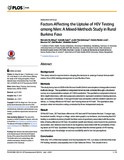| dc.contributor.author | Allegri, Manuela De | |
| dc.contributor.author | Agier, Isabelle | |
| dc.contributor.author | Tiendrebeogo, Justin | |
| dc.contributor.author | Louis, Valerie Renée | |
| dc.contributor.author | Yé, Maurice | |
| dc.contributor.author | Mueller, Olaf | |
| dc.contributor.author | Sarker, Malabika | |
| dc.date.accessioned | 2016-05-03T12:42:19Z | |
| dc.date.available | 2016-05-03T12:42:19Z | |
| dc.date.copyright | 2015 | |
| dc.date.issued | 2015-07-01 | |
| dc.identifier.citation | De Allegri, M., Agier, I., Tiendrebeogo, J., Louis, V. R., Yé, M., Mueller, O., & Sarker, M. (2015). Factors affecting the uptake of HIV testing among men: A mixed-methods study in rural Burkina Faso. PLoS ONE, 10(7), 1–15. http://doi.org/10.1371/journal.pone.0130216 | en_US |
| dc.identifier.issn | 1932-6203 | |
| dc.identifier.issn | 19326203 | |
| dc.identifier.uri | http://hdl.handle.net/10361/5207 | |
| dc.description | Includes bibliographical references (page 13-15). | |
| dc.description.abstract | Background
This study aimed to explore factors shaping the decision to undergo Human Immunodeficiency
Virus (HIV) testing among men in rural Burkina Faso.
Methods
The study took place in 2009 in the Nouna Health District and adopted a triangulation mixed
methods design. The quantitative component relied on data collected through a structured
survey on a representative sample of 1130 households. The qualitative component relied on
38 in-depth interviews, with men purposely selected to represent variation in testing decision,
age, and place of residence. A two-part model was conducted, with two distinct outcome variables,
i.e. “being offered an HIV test” and “having done an HIV test”. The qualitative data
analysis relied on inductive coding conducted by three independent analysts.
Result
Of the 937 men, 357 had been offered an HIV test and 97 had taken the test. Younger age,
household wealth, living in a village under demographic surveillance, and knowing that HIV
testing is available at primary health facilities were all positively associated with the probability
of being offered an HIV test. Household wealth and literacy were found to be positively
associated, and distance was found to be negatively associated with the probability of having
taken an HIV test. Qualitative findings indicated that the limited uptake of HIV testing
was linked to poor knowledge on service availability and to low risk perceptions.
Conclusion
With only 10% of the total sample ever having tested for HIV, our study confirmed that male
HIV testing remains unacceptably low in Sub-Saharan Africa. This results from a combination of health system factors, indicating general barriers to access, and motivational
factors, such as one’s own knowledge of service availability and risk perceptions. Our
findings suggested that using antenatal care and curative services as the exclusive entry
points into HIV testing may not be sufficient to reach large portions of the male population.
Thus, additional strategies are urgently needed to increase service uptake. | en_US |
| dc.description.statementofresponsibility | Manuela De Allegri | |
| dc.description.statementofresponsibility | Isabelle Agier | |
| dc.description.statementofresponsibility | Justin Tiendrebeogo | |
| dc.description.statementofresponsibility | Valerie Renée Louis | |
| dc.description.statementofresponsibility | Maurice Yé | |
| dc.description.statementofresponsibility | Olaf Mueller | |
| dc.description.statementofresponsibility | Malabika Sarker | |
| dc.format.extent | 15 pages | |
| dc.language.iso | en | en_US |
| dc.publisher | © 2015 PLoS ONE | en_US |
| dc.relation.uri | http://journals.plos.org/plosone/article?id=10.1371/journal.pone.0130216 | |
| dc.rights | BRAC University Journals are protected by copyright. They may be viewed from this source for any purpose, but reproduction or distribution in any format is prohibited without written permission. | |
| dc.title | Factors affecting the uptake of HIV testing among men: a mixed-methods study in rural burkina faso | en_US |
| dc.type | Article | en_US |
| dc.description.version | Published | |
| dc.contributor.department | James P Grant School of Public Health, BRAC University | |
| dc.identifier.doi | http://doi.org/10.1371/journal.pone.0130216 | |

